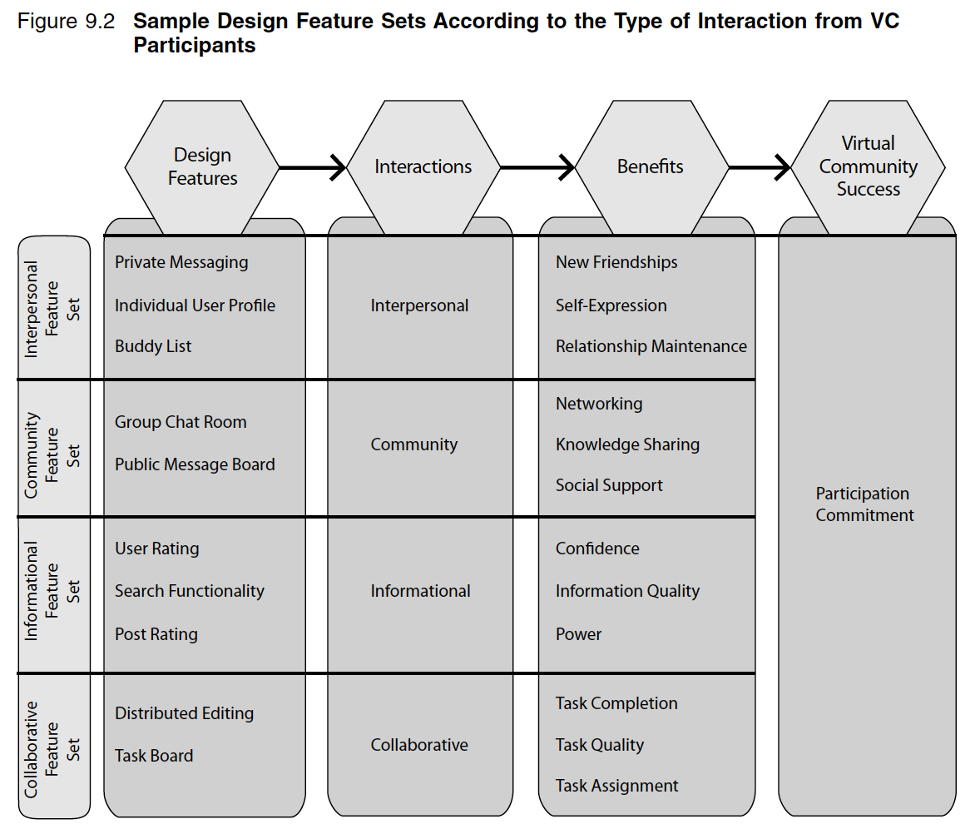
Chapter 9: Design Considerations for Virtual Communities (132)
Balaji Rajagopalan
May 3, 2020
- Uses Ridings et al.’s (2002) definition of virtual communities:
“A virtual community is a group of people with a common interest or purpose who communicate online in an organized, sustained way” - There is expectation to gain something by joining a VC
- VCs can be classified as production based (ex. open-source), and information-based (ex. message board forums)
- VCs can be open to the general public or closed within an organization
- Research has been done on motivations for participating in production- and information-based communities, competition among open virtual communities and how the design of VCs influence the user
- This paper aims to examine how specific design elements used in VC platforms provide benefits to the user and influence the VC’s overall success
Literature Review
- Research in the VC domain cover the following areas:
- “motivations of virtual community participants” (motivations of users)
- “interactions and behaviour of virtual community participants” (how users behave)
- “impacts of virtual community participation” (how user participation create impact)
- “design aspects of virtual communities” (design features of platforms)
- These four domains are used as pillars to form the conceptual framework “to explain how virtual community system design features influence user interactions, which in turn drive virtual community participant benefits that affect virtual community success”
- Reasons for participating in VCs:
- Exchange information; most popular
- Social support
- Forge friendships
- Recreation
- Common interest in community’s primary topic (domain)
- Liking design features available in the virtual community (user friendly)
- VC participants engage with users that are similar to themselves, and this creates the perception that VCs are “melting pots”
- VCs create impact for users in various ways such as the user’s reputation and the value of products in electronic marketplaces
- There are various studies done to examine how VC design features affect users’ interaction behaviour and users’ perception of the community
- Ex. Design features affect trust
- Design features allow large-scale conversations
- Social psychology theories have been integrated into VC design:
- Common identity (for large VCs) and common bond theory (for small VCs)
- There is a need to study “to understand the ways in which design choices can be implemented to best serve dynamically changing virtual communities where user attachment might evolve from bond-based to common identity-based attachment and vice versa”
- This conceptual model dives deeper from Ren at al.’s (2007) studies to understanding how design features affect VC user behaviour and impact
Conceptual Framework

- Design features cover “navigation architecture, site features and organization structures and policies”
- Ex. user profiles, inclusion of guidelines, user rating…
- There are four types of interaction:
- Interpersonal interactions
- Community interactions
- Informational interactions
- Collaborative interactions
- Each type of interaction produces different benefits to the user and community
- Virtual community success contains two characteristics: participation and commitment
- Participation – drives member content to solve problems
- Commitment – Leads to effort made for quality content
- Common Bond and Common Identity Theory
“Prentice et al. (1994) characterize common bond groups as those whose members develop attachments to individual group members whereas common identity groups form group identity attachments. Since then, research has confirmed the existence of common bond and common identity groups online (Sassenberg, 2002). Understanding the distinction between common bond and common identity theory lays the groundwork for helping us to identify the types of interactions facilitated by different types of design features.”- How do you perceive yourself compared to other individuals (common group theory)
- How do you perceive your “tribe” of UX designers to other “tribes” of UX designers in other organizations (common identity theory)
- How do you perceive UX designers compared to other professions (common identity theory)

- Could a conceptual model such as this be an outcome of my GT?
- It’s interesting to notice all these features existing in popular web based services
- Figma, Slack, Miro, Spotify, Twitch…
- Interpersonal design feature set
- Creates bond-based attachment
- Community design feature set
- Fosters identity-based attachment
- Ex. health care VC – Lung Cancer Forum at Cancer Forums (cancerforums.net)
- Informational Feature Set
- Ex. eBay seller ratings, Amazon reviews
- Ex. WebMD’s support groups rate on 5-star system
- “it shapes user impressions about VC content” and provides verification of content
- Collaborative design feature set
- Involves “distributed editing and task boards”
- Ex. Wikipedia, Google Docs, Bugzilla’s Developer Resources Web page
Discussion (Application example)
- Application of this conceptual model for the Lung Cancer Forum at the Cancer Forums cancerforums.net)
- Public message board for emotional support
Concluding Thoughts
- What motivates UX designers to seek knowledge inside the organization?
- What motivates UX designers to seek knowledge outside the organization?
- What benefits drive UX designers to continue participating in their CoP?
- How does the CoP affect the designer’s perception of themselves individually and as a group?
